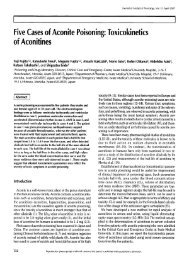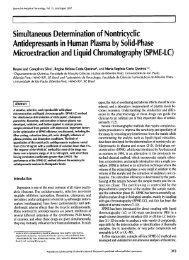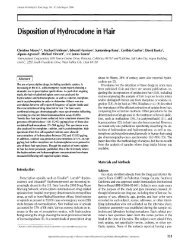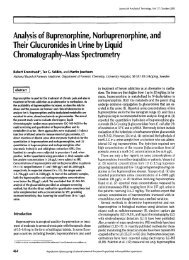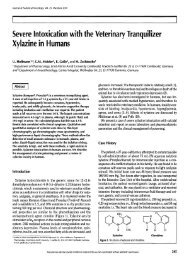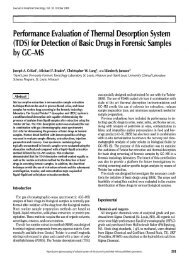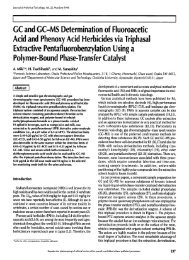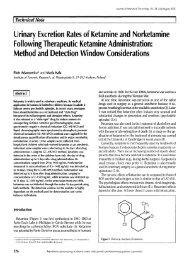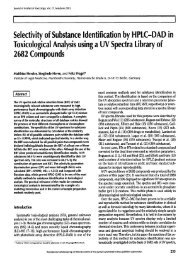Occupational Exposure to Methamphetamine in Workers Preparing ...
Occupational Exposure to Methamphetamine in Workers Preparing ...
Occupational Exposure to Methamphetamine in Workers Preparing ...
You also want an ePaper? Increase the reach of your titles
YUMPU automatically turns print PDFs into web optimized ePapers that Google loves.
Journal of Analytical Toxicology, Vol. 30, Oc<strong>to</strong>ber 2006<br />
<strong>Occupational</strong> <strong>Exposure</strong> <strong>to</strong> <strong>Methamphetam<strong>in</strong>e</strong><br />
<strong>in</strong> <strong>Workers</strong> Prepar<strong>in</strong>g Tra<strong>in</strong><strong>in</strong>g Aids for<br />
Drug Detection Dogs*<br />
P.R. S<strong>to</strong>ut 1,t, C.K. Horn 2,*, K.L. Klette 3,*, and J. Given 4,*<br />
1Center for Forensic Sciences, Research Triangle Park, North Carol<strong>in</strong>a; 2Navy Drug Screen<strong>in</strong>g Labora<strong>to</strong>ry, Jacksonville,<br />
Florida; 3Navy Drug Screen<strong>in</strong>g Labora<strong>to</strong>ry, Great Lakes, Ill<strong>in</strong>ois; and 4Naval Crim<strong>in</strong>al Investigative Service<br />
Regional Forensic Labora<strong>to</strong>ry, Norfolk, Virg<strong>in</strong>ia<br />
Abstract I<br />
As a part of ongo<strong>in</strong>g test<strong>in</strong>g of personnel prepar<strong>in</strong>g tra<strong>in</strong><strong>in</strong>g aids for<br />
drug detection dogs at the Naval Crim<strong>in</strong>al Investigative Service<br />
Regional Forensic Labora<strong>to</strong>ry, personnel handl<strong>in</strong>g<br />
methamphetam<strong>in</strong>e (MTH) were subject <strong>to</strong> voluntary ur<strong>in</strong>e drug<br />
test<strong>in</strong>g. This provided a model of potential unwitt<strong>in</strong>g or<br />
environmental exposure contribution <strong>to</strong> MTH concentrations <strong>in</strong><br />
ur<strong>in</strong>e. Ur<strong>in</strong>e samples were collected from multiple <strong>in</strong>dividuals on<br />
the day before, the day of, and the day after the <strong>in</strong>dividuals had<br />
handled up <strong>to</strong> 500-g quantities of MTH dur<strong>in</strong>g the assembly of<br />
tra<strong>in</strong><strong>in</strong>g aids. Personnel wore gloves, dust masks, and lab coats<br />
dur<strong>in</strong>g the preparation of tra<strong>in</strong><strong>in</strong>g aids. A <strong>to</strong>tal of 101 ur<strong>in</strong>e samples<br />
were analyzed for the presence of MTH and amphetam<strong>in</strong>e (AMP) by<br />
gas chroma<strong>to</strong>graphy-mass spectrometry after solid-phase extraction<br />
and derivatization. Ur<strong>in</strong>e samples collected dur<strong>in</strong>g and after<br />
personnel handled drug yielded a mean MTH concentration of<br />
48 ng/mL with a maximum concentration of 262 ng/mL and a<br />
m<strong>in</strong>imum detected concentration of approximately 1.6 ng/mL.<br />
Thirty-five of the 52 post drug-handl<strong>in</strong>g samples had detectable<br />
MTH. Ten of the samples had MTH concentrations above the<br />
method limit of quantitation of 15 ng/mL. Only one sample had a<br />
concentration greater than 50 ng/mL. None of the samples had<br />
detectable AMP. From this limited study, it was evident that handl<strong>in</strong>g<br />
of MTH under these conditions resulted <strong>in</strong> m<strong>in</strong>imal exposure and<br />
small but detectable concentrations of MTH <strong>in</strong> ur<strong>in</strong>e.<br />
Introduction<br />
Drug detection dogs are used throughout law enforcement<br />
* The views expressed <strong>in</strong> this article are those of the authors and do not necessarily reflect the<br />
official policy or position of the Department of the Navy, the Department of Defense, or the<br />
U.S. Government.<br />
~ Author <strong>to</strong> whom correspondence should be addressed: Peler R. S<strong>to</strong>ut, Ph.D., Center for<br />
Forensic Sciences, RTI International, 3040 Cornwallis Rd., Research Triangle Park, NC 27709.<br />
E-mail: ps<strong>to</strong>ut@rti.org.<br />
* The author is military service member (or employee of the U.S. Government). This work was<br />
prepared as part of my official duties. Title 17 U.S.C. 105 provides that 'Copyright protection<br />
under this title is not available for any work of the United States Government.' Title 17 U.S.C.<br />
10t def<strong>in</strong>es a United States Government work as a work prepared by a military service<br />
member or employee of the United States Government as part of that person's official duties.<br />
<strong>to</strong> assist <strong>in</strong> locat<strong>in</strong>g concealed illicit drugs or provide evidence<br />
of drug handl<strong>in</strong>g. The Department of Defense (DoD) established<br />
a tra<strong>in</strong><strong>in</strong>g facility at Lackland Air Force Base <strong>in</strong> Texas for<br />
military work<strong>in</strong>g dog tra<strong>in</strong><strong>in</strong>g. This program utilizes special<br />
tra<strong>in</strong><strong>in</strong>g aids consist<strong>in</strong>g of a ventilated canister (Figure 1) conra<strong>in</strong><strong>in</strong>g<br />
a paper packet (or b<strong>in</strong>dle) of the target drug. The Naval<br />
Crim<strong>in</strong>al Investigative Service Regional Forensic Labora<strong>to</strong>ry<br />
(NCISRFL) <strong>in</strong> Norfolk, VA has been the sole producer of these<br />
tra<strong>in</strong><strong>in</strong>g aids for the Department of Defense. Because of the relatively<br />
high numbers of tra<strong>in</strong><strong>in</strong>g aids produced and the large<br />
quantities of drugs handled, the potential for passive exposure<br />
<strong>to</strong> illicit drug has been a concern at NCISRFL. To assess<br />
the potential risk of exposure, ur<strong>in</strong>e analysis test<strong>in</strong>g has been<br />
conducted on Labora<strong>to</strong>ry personnel s<strong>in</strong>ce 1995. These tests<br />
have been conducted by the Navy Drug Screen<strong>in</strong>g Labora<strong>to</strong>ry<br />
<strong>in</strong> Jacksonville, FL (NDSL-Jacksonville) s<strong>in</strong>ce this moni<strong>to</strong>r<strong>in</strong>g<br />
was implemented.<br />
Personnel handl<strong>in</strong>g large quantities of illicit drugs (approximately<br />
500 g at a time) <strong>in</strong> the preparation of drug detection<br />
tra<strong>in</strong><strong>in</strong>g aids are an ideal population <strong>to</strong> gather <strong>in</strong>formation<br />
regard<strong>in</strong>g the potential for passive exposure <strong>to</strong> illicit drugs.<br />
This <strong>in</strong>formation is of importance <strong>to</strong> refute or support claims<br />
that a positive ur<strong>in</strong>e analysis result (upon which legal action<br />
might be taken) was the result of passive exposure. Additionally,<br />
this is important <strong>to</strong> the <strong>in</strong>terpretation of ur<strong>in</strong>e drug<br />
test<strong>in</strong>g results of law enforcement personnel unwitt<strong>in</strong>gly or<br />
know<strong>in</strong>gly exposed <strong>to</strong> illicit drugs on the job.<br />
Several <strong>in</strong>vestigations have exam<strong>in</strong>ed the potential for coca<strong>in</strong>e<br />
exposure <strong>in</strong> medical and occupational sett<strong>in</strong>gs and have<br />
demonstrated some exposure risk <strong>in</strong> handl<strong>in</strong>g coca<strong>in</strong>e (1-5).<br />
Gelhausen et al. (4,5) conducted studies of coca<strong>in</strong>e exposure <strong>in</strong><br />
NCISRFL personnel produc<strong>in</strong>g coca<strong>in</strong>e-conta<strong>in</strong><strong>in</strong>g tra<strong>in</strong><strong>in</strong>g<br />
aids and found some potential for coca<strong>in</strong>e exposure that could<br />
be mitigated by the use of personal protective equipment and<br />
Labora<strong>to</strong>ry chemical fume hoods. These results suggested that<br />
<strong>in</strong>halation of airborne coca<strong>in</strong>e particles was a primary exposure<br />
route. However, exposure by <strong>to</strong>uch<strong>in</strong>g the mouth, nose, and<br />
eyes with contam<strong>in</strong>ated f<strong>in</strong>gers may also have been mitigated<br />
by the use of personal protective equipment.<br />
Reproduction (pho<strong>to</strong>copy<strong>in</strong>g) of edi<strong>to</strong>rial content of this journal is prohibited without publisher's permission. 551
Journal of Analytical Toxicology, Vol. 30, Oc<strong>to</strong>ber 2006<br />
There is little evidence <strong>in</strong> the literature for potential passive<br />
exposure <strong>to</strong> methamphetam<strong>in</strong>e (MTH) <strong>to</strong> result <strong>in</strong> a positive<br />
ur<strong>in</strong>alysis. Significant problems or issues with illegal MTH production<br />
and child welfare have been addressed (6,7), and use of<br />
ur<strong>in</strong>e and hair test<strong>in</strong>g <strong>to</strong> <strong>in</strong>dicate the exposure of children <strong>to</strong> illicit<br />
drug is often the foundation for removal of the children<br />
from those environments. Most published work related <strong>to</strong> MTH<br />
and occupational exposure details hazards of manufactur<strong>in</strong>g byproducts<br />
and hazardous materials handl<strong>in</strong>g (8).<br />
The purpose of this study was <strong>to</strong> exam<strong>in</strong>e and report the ur<strong>in</strong>alysis<br />
results of NCISRFL staff who manufacture MTH-conta<strong>in</strong><strong>in</strong>g<br />
tra<strong>in</strong><strong>in</strong>g aids and <strong>to</strong> provide some <strong>in</strong>dication of the<br />
potential for passive exposure <strong>to</strong> MTH <strong>in</strong> produc<strong>in</strong>g positive<br />
ur<strong>in</strong>e analysis results.<br />
Methods<br />
Manufacture of tra<strong>in</strong><strong>in</strong>g aids<br />
The manufacture of tra<strong>in</strong><strong>in</strong>g aids consisted of four process<br />
steps: gr<strong>in</strong>d<strong>in</strong>g, weigh<strong>in</strong>g, stuff<strong>in</strong>g, and seal<strong>in</strong>g. Commercially<br />
purchased D-MTH hydrochloride (Chattem Chemical, Chattanooga,<br />
TN) samples <strong>in</strong> excess of the amount required for<br />
preparation were ground <strong>in</strong><strong>to</strong> a f<strong>in</strong>e powder us<strong>in</strong>g a mortar and<br />
pestle. The MTH was then weighed <strong>in</strong><strong>to</strong> quantities of 1-5 g<br />
us<strong>in</strong>g an analytical balance. These weighed samples were transferred<br />
<strong>to</strong> or "stuffed" <strong>in</strong><strong>to</strong> pre-folded filter paper b<strong>in</strong>dles and<br />
stapled closed. The b<strong>in</strong>dles were placed <strong>in</strong><strong>to</strong> 3-oz t<strong>in</strong> canisters<br />
(Figure 1) and sealed with wire and a forensic lead disk.<br />
Ur<strong>in</strong>e samples<br />
Dur<strong>in</strong>g tra<strong>in</strong><strong>in</strong>g aid preparation, NCISRFL staff ur<strong>in</strong>e samples<br />
were collected throughout the day. Generally, ur<strong>in</strong>e samples<br />
were collected from each technician at the beg<strong>in</strong>n<strong>in</strong>g of the<br />
shift, at mid-shift and at the end of each shift. Samples were<br />
s<strong>to</strong>red <strong>in</strong> secured refrigera<strong>to</strong>rs prior <strong>to</strong> shipment <strong>to</strong> NDSL-<br />
Jacksonville for analysis. Samples were ma<strong>in</strong>ta<strong>in</strong>ed under strict<br />
cha<strong>in</strong> of cus<strong>to</strong>dy procedures from collection <strong>to</strong> analysis.<br />
Sample preparation<br />
Ur<strong>in</strong>e samples were analyzed by a solid-phase extraction<br />
method previously described <strong>in</strong> S<strong>to</strong>ut et al. (9). Briefly, samples<br />
were extracted us<strong>in</strong>g SPEWare (San Pedro, CA) columns on a<br />
Speedisk | 48 positive-pressure extraction manifold system.<br />
Deuterated <strong>in</strong>ternal standards of AMP and MTH purchased<br />
from Cerilliant (Round Rock, TX) were added <strong>to</strong> the samples<br />
prior <strong>to</strong> extraction and derivatization. Samples were then analyzed<br />
by a gas chroma<strong>to</strong>graph-mass spectrometer operated <strong>in</strong><br />
electron-impact selected ion moni<strong>to</strong>r<strong>in</strong>g mode. The limit of<br />
quantitation (LOQ) for these MTH analyses was approximately<br />
15 ng/mL, and the limit of detection (LOD, def<strong>in</strong>ed as the<br />
lowest concentration at which all ion ratios, chroma<strong>to</strong>graphy,<br />
and retention times were acceptable) was approximately 1<br />
ng/mL MTH.<br />
Results and Discussion<br />
Table I summarizes the number of <strong>in</strong>dividuals tested, the<br />
<strong>to</strong>tal number of samples analyzed and the distribution of the<br />
times <strong>in</strong> the process that ur<strong>in</strong>e samples were collected. Of the<br />
101 samples analyzed, slightly less than half were collected<br />
prior <strong>to</strong> drug handl<strong>in</strong>g with 6 samples collected dur<strong>in</strong>g process<strong>in</strong>g<br />
(represent<strong>in</strong>g 5 <strong>in</strong>dividuals). Table II presents the MTH<br />
concentration of all 37 samples demonstrat<strong>in</strong>g the presence of<br />
MTH. Ten samples had concentrations greater than the LOQ.<br />
All samples presented <strong>in</strong> Table II were collected dur<strong>in</strong>g or after<br />
production of tra<strong>in</strong><strong>in</strong>g aids with the exception of samples 1 and<br />
4. These samples were collected from the <strong>in</strong>dividual who was<br />
also responsible for the test<strong>in</strong>g of the tra<strong>in</strong><strong>in</strong>g aids and as such<br />
had additional exposure potential outside of produc<strong>in</strong>g the<br />
tra<strong>in</strong><strong>in</strong>g aids. None of the samples conta<strong>in</strong>ed any detectable<br />
levels of AMP.<br />
A solvent blank was <strong>in</strong>jected between each NCISRFL sample,<br />
and <strong>in</strong> all cases, the solvent blank did not demonstrate any<br />
qualitative <strong>in</strong>dication of MTH carry-over. Additionally, process<br />
Table I. Summary of the Samples Collected <strong>in</strong> the Study<br />
Period<br />
Number<br />
Figure 1. Tra<strong>in</strong><strong>in</strong>g aid canister show<strong>in</strong>g filter paper b<strong>in</strong>dle and f<strong>in</strong>al canister<br />
with lead seal.<br />
Individuals tested 5<br />
Total samples analyzed<br />
10r<br />
Samples collected before exposure 49<br />
Samples collected dur<strong>in</strong>g process 6<br />
Samples collected after exposure (next day) 46<br />
552
Journal of Analytical Toxicology, Vol. 30, Oc<strong>to</strong>ber 2006<br />
controls for the conversion of ephedr<strong>in</strong>e or pseudoephedr<strong>in</strong>e<br />
<strong>to</strong> MTH dur<strong>in</strong>g sample process<strong>in</strong>g did not demonstrate any<br />
MTH <strong>in</strong> any analysis. Therefore even at the very low concentrations<br />
observed <strong>in</strong> these samples, MTH results were not artifactual.<br />
A statistical summary of the positive results obta<strong>in</strong>ed from<br />
collected samples is presented <strong>in</strong> Table III. Sample # 15 was notable<br />
as it conta<strong>in</strong>ed the maximum observed concentration of<br />
MTH (262 ng/mL). This sample was collected at 0717 on the<br />
day follow<strong>in</strong>g manufacture operations and potential exposure<br />
(approximately 16 h after the end of any activities the previous<br />
day when the <strong>in</strong>dividual was stuff<strong>in</strong>g the b<strong>in</strong>dles with<br />
ground MTH). The pre-process<strong>in</strong>g sample taken from the same<br />
<strong>in</strong>dividual the morn<strong>in</strong>g prior <strong>to</strong> manufacture operations had<br />
no detectable MTH. No notable reasons for the high result<br />
were determ<strong>in</strong>ed.<br />
Conclusions<br />
Table II. All Samples Conta<strong>in</strong><strong>in</strong>g Detectable <strong>Methamphetam<strong>in</strong>e</strong> from the<br />
101 Samples Tested*<br />
Sample Concentration Date Sample Concentration Date<br />
Number (ng/mL) Collected Number (ng/mL) Collected<br />
1 ~ 9.0 5/8/2002 20 9.1 8/25/2003<br />
2 43 5/8/2002 21 9.4 10/31/2003<br />
3 15 5/8/2002 22 3.8 10/31/2003<br />
4 t 16 9/24/2002 23 9.3 10/31/2003<br />
5 36 9/24/2002 24 11 10/31/2003<br />
6 1.6 9/24/2002 25 6.5 1/28/2004<br />
7 11 9/24/2002 26 22 1/28/2004<br />
8 13 9/24/2002 27 24 1/28/2004<br />
9 6.7 1/31/2003 28 27 1/28/2004<br />
10 15 1/31/2003 29 3.0 6/15/2004<br />
11 3.1 1/31/2003 30 2.3 6/15/2004<br />
12 4.0 1/31/2003 31 10 6/15/2004<br />
13 12 1/23/2003 32 11 6/15/2004<br />
14 15 1/23/2003 33 2.6 6/15/2004<br />
15 262 1/23/2003 34 10 9/9/2004<br />
16 13 1/23/2003 35 5.4 9/9/2004<br />
17 2.6 6/2/2003 36 10 9/9/2004<br />
18 2.1 6/2/2003 37 12 9/9/2004<br />
19 9.1 8/25/20o3<br />
* Note that the limit of quantitation was 15 ng/mL, and the limit of detection was 1 ng/mL. Values less than 15<br />
ng/mL are given because all chroma<strong>to</strong>graphic acceptance criteria were acceptable, <strong>in</strong>dicat<strong>in</strong>g the presence<br />
of MTH <strong>in</strong> the sample; however, the quantitative value is not reliable.<br />
Samples were collected immediately prior <strong>to</strong> start<strong>in</strong>g process<strong>in</strong>g.<br />
Table III. Summary Statistics of the Samples Collected<br />
Dur<strong>in</strong>g and After Production of Tra<strong>in</strong><strong>in</strong>g Aids Conta<strong>in</strong><strong>in</strong>g<br />
Detectable <strong>Methamphetam<strong>in</strong>e</strong><br />
Statistics for<br />
Values above LOQ<br />
Statistics with All<br />
Values above LOD<br />
Mean 48 ng/mL 13.7 ng/mL<br />
M<strong>in</strong>imum 15 ng/mL 0 ng/mL<br />
Maximum 262 ng/mL 262 ng/mL<br />
Standard deviation 75 38.6<br />
Number > LOQ (or ND) 10 35<br />
Dur<strong>in</strong>g the preparation of drug detection dog tra<strong>in</strong><strong>in</strong>g aids,<br />
Labora<strong>to</strong>ry personnel had both dermal and airborne contact<br />
with MTH. This exposure may be considered analogous <strong>to</strong> the<br />
handl<strong>in</strong>g of large (~ 500 g) quantities of MTH as might occur<br />
for law enforcement personnel. The results of this study<br />
demonstrated that very low levels of MTH are detectable <strong>in</strong> the<br />
ur<strong>in</strong>e on the morn<strong>in</strong>g follow<strong>in</strong>g exposure; however, these levels<br />
were far below any regula<strong>to</strong>ry cu<strong>to</strong>ffs used <strong>in</strong> ur<strong>in</strong>e drug<br />
test<strong>in</strong>g, and AMP was not present. From these data, it appears<br />
that exposure <strong>in</strong> a reasonably controlled environment (e.g.,<br />
labora<strong>to</strong>ry sett<strong>in</strong>g) <strong>to</strong> small quantities of MTH is not likely <strong>to</strong><br />
result <strong>in</strong> significant concentrations of MTH <strong>in</strong> ur<strong>in</strong>e.<br />
For personnel whose job functions may take them <strong>in</strong><strong>to</strong> clandest<strong>in</strong>e<br />
MTH labs without personnel protective equipment,<br />
exposure <strong>to</strong> MTH may present more of an<br />
issue. Certa<strong>in</strong>ly, exposure <strong>to</strong> other chemical<br />
hazards at such sites warrants the use of protective<br />
equipment.<br />
Acknowledgments<br />
The authors would like <strong>to</strong> acknowledge the<br />
staff of NDSL-Jacksonville for their work <strong>in</strong><br />
analysis of the samples and the NCISRFL staff<br />
for voluntarily provid<strong>in</strong>g the samples for this<br />
study.<br />
References<br />
1. M.A. EISohly. Ur<strong>in</strong>alysis and casual handl<strong>in</strong>g<br />
of marijuana and coca<strong>in</strong>e. J. Anal. Toxicol.<br />
15"46 (1991).<br />
2. S.D. Le, R.W. Taylor, D. Vidal, J.J. Lovas, and<br />
E. T<strong>in</strong>g. <strong>Occupational</strong> exposure <strong>to</strong> coca<strong>in</strong>e <strong>in</strong>volv<strong>in</strong>g<br />
crime lab personnel. J. Forensic Sci.<br />
37:959-968 (1992).<br />
3. L.S. Fitzmaurice, G.S. Wasserman, J,F. Knapp,<br />
D.K. Roberts, J.F. Waeckerle, and M. Fox. TAC<br />
use and absorption of coca<strong>in</strong>e <strong>in</strong> a pediatric<br />
emergency department. Ann. Emerg. Med. 19"<br />
515-518 (1990).<br />
4. J.M. Gehlhausen, K.L. Klette, and J. Given.<br />
Ur<strong>in</strong>e analysis of labora<strong>to</strong>ry personnel prepar<strong>in</strong>g<br />
tra<strong>in</strong><strong>in</strong>g aids for a military work<strong>in</strong>g dog program.<br />
J. Anal. Toxicol. 25" 637-640 (2001).<br />
5. J.M. Gehlhausen, K.L. Klette, P.R. S<strong>to</strong>ut, and J. Given. <strong>Occupational</strong><br />
coca<strong>in</strong>e exposure of crime labora<strong>to</strong>ry personnel prepar<strong>in</strong>g<br />
tra<strong>in</strong><strong>in</strong>g aids for a military work<strong>in</strong>g dog program. J. AnaL Toxicol.<br />
27:453-458 (2003).<br />
6. D. Lewis, C. Moore, P. Morrissey, and J. Leik<strong>in</strong>. Determ<strong>in</strong>ation of<br />
drug exposure us<strong>in</strong>g hair: application <strong>to</strong> child protective cases.<br />
Forensic ScL Int. 84:123-128 (1997).<br />
7. M. Hohman, R. Oliver, and W. Wright. <strong>Methamphetam<strong>in</strong>e</strong> abuse<br />
and manufacture: the child welfare response. Soc. Work 49:<br />
373-381 (2004).<br />
8. D.K. Hor<strong>to</strong>n, Z. Berkowitz, and W.E. Kaye. Secondary contam<strong>in</strong>ation<br />
of ED personnel from hazardous materials events,<br />
1995-2001. Am. J. Ernerg. Med. 21 : 199-204 (2003).<br />
553



